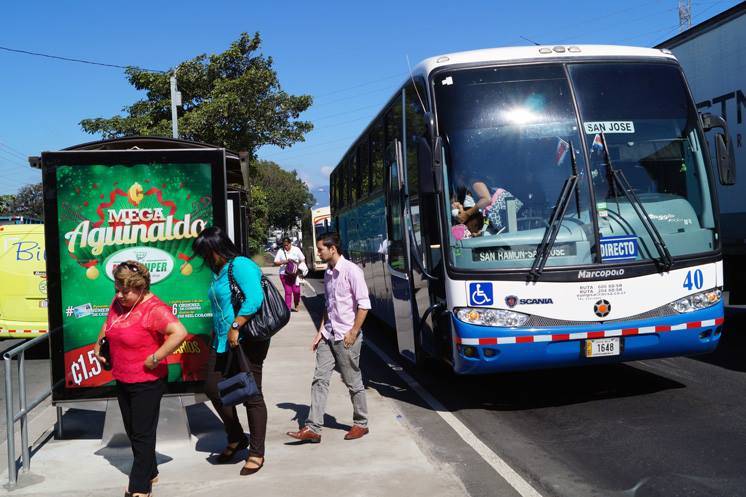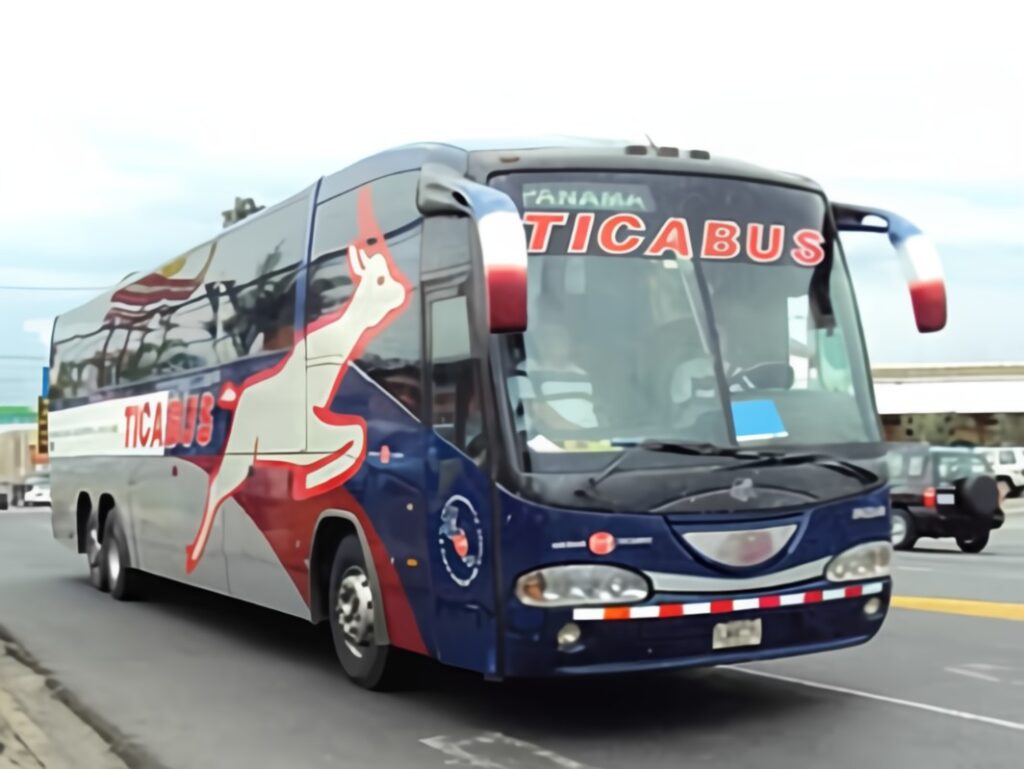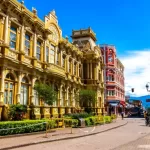Traveling by Bus in Costa Rica for expats
Bus travel is both affordable and accessible. Tourists, expat retirees and Costa Ricans can travel by bus to virtually any part of the country. Costa Ricans who cannot not afford an automobile depend exclusively on the country’s many bus lines to be able to travel to and from their jobs.
City bus travel
Bus fares from San José to the surrounding suburbs and towns in the Central Valley is are very affordable. On urban and inter-urban buses, you pay the driver as you board.
Traveling by bus around San José or to the surrounding suburbs may seem quite difficult to a newcomer. However, once you get the hang of it, you will find it a surprisingly easy and affordable way to travel. Most expatriates who do not have cars use the city’s excellent bus system. Those who own cars prefer taking buses to avoid traffic and paying for parking.

If you do not know where to catch a specific city bus to your destination, then you will have to ask someone. Also, you might want to ask a policeman who can usually help.
When you finally find your bus stop, you should not assume that every bus that stops there goes to your destination. It is not unusual to have several buses with different routes using the same bus stop.
When in doubt, try to ask someone who is waiting, “¿A dónde va este autobús?” (Where does this bus go?). Another thing you can do is look at the sign displayed somewhere on the windshield or on the lower left-hand-corner of the front window. These signs will list the destination of the bus.
Once you figure out which bus to take, have your change in hand and be ready to pay the bus fare. You can usually find out how much the fare is by asking one of the people waiting or by looking at the sign in the bus’s window. Do not be in a hurry to board since some passengers may exit through the front door.
Currently, when you get inside the bus, hand the driver your fare. If you do not have the exact amount the driver will make change. Try to avoid giving the driver anything larger than a 2,000 colón bill. Be careful not to stand between the electronic counter or the driver will get mad. They were installed to replace the turnstiles most buses had in the past. These devices have an electric eye and count the number of people who use the bus. Once, a friend of mine boarded a bus, and his young son accidentally stood in front of the electric counter. The driver made my friend pay an extra fare because he would have had to pay the amount out of his own pocket.
It was announced that within a couple of years, city buses fares will be paid by a special pre-paid card and not with cash. This way the driver will no longer have to handle money or make change. Most bus companies plan to use this system (* NOTE: The Government, through the inter-institutional coordination of the Central Bank of Costa Rica (BCCR), Ministry of Public Works and Transport (MOPT), Costa Rican Institute of Railways (INCOFER) and the Regulatory Authority of Public Services (ARESEP), is advancing in the implementation of the Electronic Payment System for public buses throughout the country.)
Next, you will need to find a seat. It is advisable not to sit on the sunny side of the bus. A large number of buses have large windows with no curtains. If you sit on the side where the sun hits, you may feel like you are under a magnifying glass. However, many of the newer buses have curtains that you can draw to keep out the sun.
During rush hour, buses tend to be very crowded and you often have to stand if you cannot find a seat. In this case, take hold of one of the horizontal bars. Most buses start and stop with a jerky motion and it is easy to fall if you are standing and not holding on to something.
Be sure to let the driver know about a block before you want to get off. You can do this by pressing a button. Buses usually have one of these devices. If you cannot locate the button, or it does not work, then yell, “Parada!” (Stop!), so the driver will know to let you off at the next stop. If you do not know at which bus stop to get off, ask the driver or someone else on the bus. Usually, the name of a street, neighborhood or landmark will suffice. If you let the driver know where you want to be let off upon boarding, he will usually remember to tell you when you reach your stop.
*Here is how to find your bus stop check https://moovitapp.com/index/en/public_transit-Costa_Rica
Bus travel around Costa Rica
For a very low cost expat retirees and others can take a bus to almost anywhere in the country. Most Costa Ricans do not own cars, so they depend on buses for traveling to other areas of the country. Riding a bus provides the perfect opportunity to get to know people on a personal basis, see the lovely countryside and learn something about the country and the culture. Most buses used for these longer trips are modern and extremely comfortable. Unlike in some parts of Latin America, Costa Rica’s long-haul buses are not filled with chickens and other small animals and standing is not allowed. Buses are crowded on weekends and holidays, so buy your tickets in advance or get to the station early. Be sure to check for schedule changes.
All buses depart from terminals in the San Jose area.. Contact the bus terminal for the most recent schedule and the cost of a ticket to your destination.
Check on line or with some knowledgeable person who is familiar with bus schedules and knows the different bus stops or where the main terminals are located See: https://centrocoasting.com/costarica/
Interbus (www.interbusonline.com), Costa Rica Shuttle (https://costaricashuttle.com/site/) and Easy Ride (https://www.easyridecostarica.com/) offer direct tours between many of the country’s major tourist attractions. These companies offer transportation to more than 40 destinations and have offices around the country. Check out https://costa-rica-guide.com/travel/transportation/bus-schedule/
Bus Travel to and from Costa Rica
If you want to travel to Guatemala, Panama, or other Central American countries, you can use the bus services listed. Those who live in Costa Rica permanently without being a legal residents (we DON’T recommend this), can take a bus to Panama or Nicaragua, return to Costa Rica after crossing the border, and thus renew their papers so they can remain legally in the country for another 90 days. Many foreigners living as “perpetual tourists” in Costa Rica go through this procedure every few months to stay legal and avoid Immigration hassles.

From time to time, the Immigration asks to see a return ticket before extending tourist cards. So, it is a good idea to buy an inexpensive bus ticket to a neighboring country to prove you can leave the country.
Tica Bus (Tel: +506 2296-9788, E-mail: info@ticabus.com, www.ticabus.com) offers bus service to the rest of Central America.
Long distance bus tickets can now be purchased in advance and on-line.
Check https://horariodebuses.com/EN/cr/index.php or https://centrocoasting.com/costarica/
Traveling with pets
Travel with pets is allowed when they weigh less than 10 kilograms. The animal must be in an approved carrier, with a secure lock and a waterproof and odorless bottom. The owner must keep an eye on the pet during the whole journey to prevent it from being a nuisance for the rest of the passengers.
The regulations for animals on public transport are different for guide dogs. Guide dogs may always travel on the bus regardless of their weight. They must remain leashed and accompanied by their owner. At the same time, the owner should travel with the animal’s official documentation in case he/she is asked for it at any time. Guide dogs or assistance dogs may travel on the intercity bus at no additional cost and will travel in the central aisle of the passenger cabin, accompanying their owner.
For intercity travel, passengers may only travel with pets weighing up to 10 kilograms. In addition, the pet will not travel with him in the cabin, but in the hold. For this purpose, the pet must travel in a rigid carrier, with a secure lock and a waterproof bottom in case of vomiting or bowel movements.



